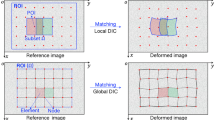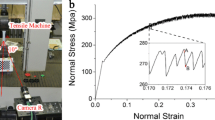Abstract
High-efficiency and high-accuracy deformation analysis using digital image correlation (DIC) has become increasingly important in recent years, considering the ongoing trend of using higher resolution digital cameras and common requirement of processing a large sequence of images recorded in a dynamic testing. In this work, to eliminate the redundant computations involved in conventional DIC method using forward additive matching strategy and classic Newton–Raphson (FA-NR) algorithm without sacrificing its sub-pixel registration accuracy, we proposed an equivalent but more efficient DIC method by combining inverse compositional matching strategy and Gauss-Newton (IC-GN) algorithm for fast, robust and accurate full-field displacement measurement. To this purpose, first, an efficient IC-GN algorithm, without the need of re-evaluating and inverting Hessian matrix in each iteration, is introduced to optimize the robust zero-mean normalized sum of squared difference (ZNSSD) criterion to determine the desired deformation parameters of each interrogated subset. Then, an improved reliability-guided displacement tracking strategy is employed to achieve further speed advantage by automatically providing accurate and complete initial guess of deformation for the IC-GN algorithm implemented on each calculation point. Finally, an easy-to-implement interpolation coefficient look-up table approach is employed to avoid the repeated calculation of bicubic interpolation at sub-pixel locations. With the above improvements, redundant calculations involved in various procedures (i.e. initial guess of deformation, sub-pixel displacement registration and sub-pixel intensity interpolation) of conventional DIC method are entirely eliminated. The registration accuracy and computational efficiency of the proposed DIC method are carefully tested using numerical experiments and real experimental images. Experimental results verify that the proposed DIC method using IC-GN algorithm and the existing DIC method using classic FA-NR algorithm generate similar results, but the former is about three to five times faster. The proposed reliability-guided IC-GN algorithm is expected to be a new standard full-field displacement tracking algorithm in DIC.











Similar content being viewed by others
References
Peters WH, Ranson WF (1981) Digital imaging techniques in experimental stress analysis. Opt Eng 21:427–431
Chu TC, Ranson WF, Sutton MA, Peters WH (1985) Applications of digital-image-correlation techniques to experimental mechanics. Exp Mech 25:232–244
Sutton MA, Orteu JJ, Schreier HW (2009) Image correlation for shape, motion and deformation measurements. Springer
Pan B, Qian KM, Xie HM, Asundi A (2009) Two-dimensional digital image correlation for in-plane displacement and strain measurement: a review. Meas Sci Technol 20:062001
Pan B (2011) Recent progress in digital image correlation. Exp Mech 51:1223–1235
Hild F, Roux S (2006) Digital image correlation: from displacement measurement to identification of elastic properties—a review. Strain 42(2):69–80
Huang JY, Zhu T, Pan XY, Qin L, Peng XL, Xiong CY, Fang J (2010) A high-efficiency digital image correlation method based on a fast recursive scheme. Meas Sci Technol 21:035101
Wang ZY, Hoang TM, Nguyen DA, Urcinas AC, Magro JR (2010) High-speed digital-image correlation method: comment. Opt Lett 35:2891
Pan B, Li K (2011) A fast digital image correlation method for deformation measurement. Opt Lasers Eng 49:841–847
Bruck HA, McNeil SR, Sutton MA, Peters WH (1989) Digital image correlation using Newton–Raphson method of partial differential correction. Exp Mech 29:261–267
Vendroux G, Knauss WG (1998) Submicron deformation field measurements: Part 2. Improved digital image correlation. Exp Mech 38:86–92
Lu H, Cary PD (2000) Deformation measurement by digital image correlation: implementation of a second-order displacement gradient. Exp Mech 40:393–400
Pan B, Xie HM, Guo ZQ, Hua T (2007) Full-field strain measurement using a two-dimensional Savitzky-Golay digital differentiator in digital image correlation. Opt Eng 46(3):033601
Pan B (2009) Reliability-guided digital image correlation for image deformation measurement. Appl Opt 48:1535–1542
Pan B, Wang ZY, Lu ZX (2010) Genuine full-field deformation measurement of an object with complex shape using reliability-guided digital image correlation. Opt Express 18:1011–1023
Huang J, Pan X, Peng X, Yuan Y, Xiong C, Fang J, Yuan F (2012) Digital image correlation with self-adaptive Gaussian windows. Exp Mech, 10.1007/s11340-012-9639-8
Pan B, Xie HM, Xu BQ, Dai FL (2006) Performance of sub-pixel registration algorithms in digital image correlation. Meas Sci Tech 17(6):1615–1621
Tong W, Yao H, Xuan Y (2011) An improved error evaluation in one-dimensional deformation measurements by linear digital image correlation. Exp Mech 51(9):1019–1031
Tong W (2011) Subpixel image registration with reduced bias. Opt Lett 36(5):763–765
Baker S, Mattews I (2001) Equivalence and efficiency of image alignment algorithms. Proc IEEE Conf Comput Vis Pattern Recognit 56:1090–1097
Baker S, Mattews I (2004) Lucas-Kanade 20 years on: a unifying framework. Int J Comput Vision 56:221–255
Lucas B, Kanade T (1981) An iterative image registration technique with an application to stereo vision. In Proceedings of the International Joint Conference on Artificial Intelligence, 674–679
Pan B, Asundi A, Xie HM, Gao JX (2009) Digital image correlation using iterative least squares and pointwise least squares for displacement field and strain field measurements. Opt Lasers Eng 47(7–8):865–874
Tong W (2005) An evaluation of digital image correlation criteria for strain mapping applications. Strain 41(4):167–175
Pan B, Xie HM, Wang ZY (2010) Equivalence of digital image correlation criteria for pattern matching. Appl Opt 49:5501–5509
Zhang JQ, Zeng P, Lei LP, Ma Y (2012) Initial guess by improved population-based intelligent algorithms for large inter-frame deformation measurement using digital image correlation. Opt Lasers Eng 50(3):473–490
Zhou YH, Pan B, Chen YQ (2012) Large deformation measurement using digital image correlation: a full automatic approach. Appl Opt 51(31):7674–7683
Zhou YH, Chen YQ (2012) Propagation function for accurate initialization and efficiency enhancement of digital image correlation. Opt Lasers Eng 50(12):1789–1797
Pan B, Wu DF, Xia Y (2010) High-temperature deformation field measurement by combing transient aerodynamic heating system and reliability-guided digital image correlation. Opt Lasers Eng 48(9):841–848
Press WH (2003) C++ numerical algorithms. Publishing House of Electronics Industry, Beijing
Pan B, Lu ZX, Xie HM (2010) Mean intensity gradient: an effective global parameter for quality assessment of the speckle patterns used in digital image correlation. Opt Lasers Eng 48(4):469–477
Wang YQ, Sutton MA, Bruch HA, Schreier HW (2009) Quantitative error assessment in pattern matching: effects of intensity pattern noise, interpolation, strain and image contrast on motion measurement. Strain 45:160–178
Acknowledgments
This work reported here is supported by the National Natural Science Foundation of China (Grant Nos. 11272032, 11002012 and 91216301), the Program for New Century Excellent Talents in University, the China Aerospace Science and Technology Innovation Fund Project (Grant No. CASC201101), the Aeronautical Science Foundation of China (Grant No. 2011ZD51043), the Specialized Research Fund for the Doctoral Program of Higher Education (Grant No. 20101102120015).
Author information
Authors and Affiliations
Corresponding author
Rights and permissions
About this article
Cite this article
Pan, B., Li, K. & Tong, W. Fast, Robust and Accurate Digital Image Correlation Calculation Without Redundant Computations. Exp Mech 53, 1277–1289 (2013). https://doi.org/10.1007/s11340-013-9717-6
Received:
Accepted:
Published:
Issue Date:
DOI: https://doi.org/10.1007/s11340-013-9717-6




